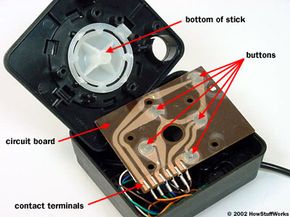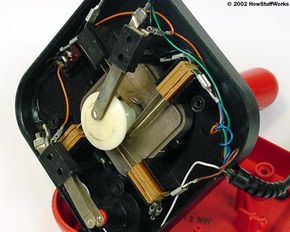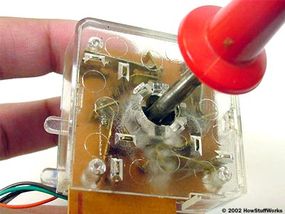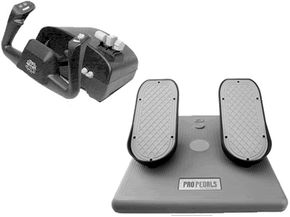The basic idea of a force feedback joystick (also called a haptic feedback joystick) is to move the stick in conjunction with onscreen action. For example, if you're shooting a machine gun in an action game, the stick would vibrate in your hands. Or if you crashed your plane in a flight simulator, the stick would push back suddenly.
Force feedback joysticks have most of the same components as ordinary joysticks, with a few important additions -- an onboard microprocessor, a couple of electrical motors and either a gear train or belt system.
The X-axis and Y-axis shafts connected to the stick both engage a belt pulley. The other end of the belt for each axis engages a motor's axle. In this setup, rotating the motor axle will move the belt to pivot the shaft, and pivoting the shaft will move the belt to rotate the motor axle. The belt's function is to transmit and amplify the force from the motor to the shaft.
Both an electrical signal from the onboard processor and the physical movement of the joystick will rotate the motor axle. In this way, you can still move the joystick even when the motor is moving it.
On the opposite end of the motor, the axle is connected to the joystick's position sensors (its potentiometers or optical sensors, for example). Whenever the stick moves, whether due to the motor or the player, the sensors detect its position.
The joystick has a built-in ROM chip that stores various sequences of motor movement. For example, it might have a machine gun sequence that instructs the motors to rapidly change direction, or a bazooka sequence that instructs the motor to shift the joystick backward suddenly and then forward again. The game software requests a particular sequence, and the computer transmits the request to the joystick's onboard processor, which brings up the appropriate data from its own memory. This reduces the work load on the computer and makes for faster reaction times.
As joysticks continue to evolve, manufacturers will take force feedback technology to whole new levels. This is great for avid gamers, of course, but it could also have a big effect on the rest of the population. Force feedback controller technology could lead to significant changes in industrial machinery, wheelchairs and other equipment for handicapped people, and even medical care. Researchers are also developing force feedback controllers to let people "feel" the Internet as they surf.
The possible applications are endless! In the future, joysticks could be as ubiquitous as computer keyboards are today.
For more information on these future prospects, as well as current and past joystick technology, check out the links on the next page.





